Technisonic T1088A 800 rf modular User Manual
Technisonic Industries Limited 800 rf modular
Contents
- 1. users manual
- 2. usrs maual 2
usrs maual 2

MULTIBAND P25
AIRBORNE TRANSCEIVER
MODEL TDFM-600/6000
Installation and
Operating Instructions
Til Document No.
01RE293
Rev. C
Issue 5
February 2004
Technisonic Industries Limited
240 Traders Blvd, Mississauga, Ontario L4Z 1W7
Tel:(905)890-2113 Fax:(905)890-5338
www.til.ca
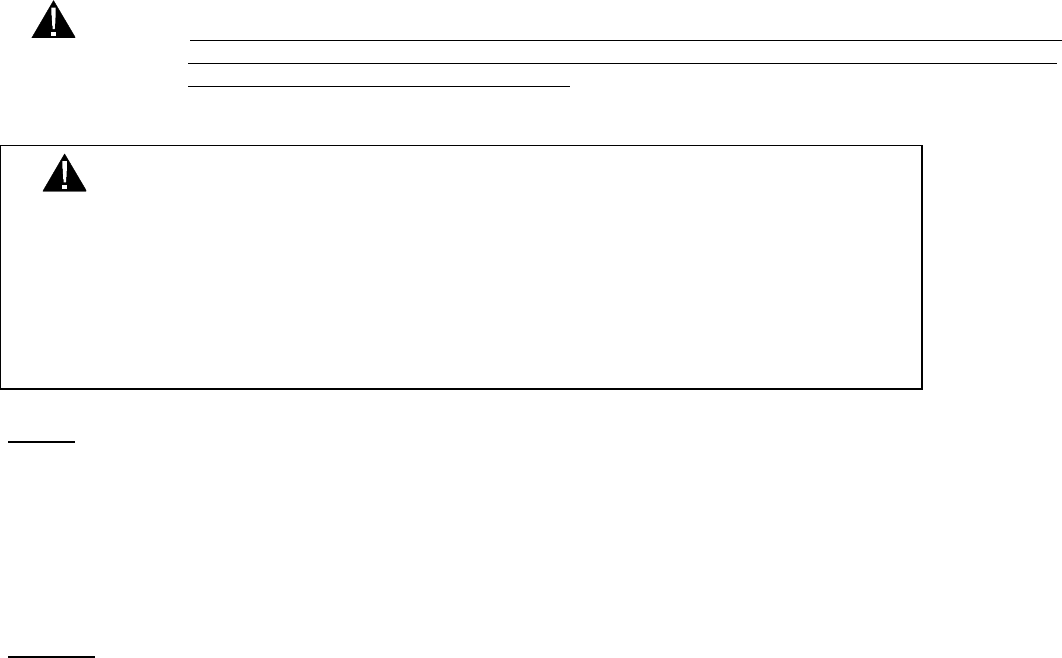
CAUTION
This unit contains static sensitive devices. Wear a grounded wrist strap and/or conductive gloves when handling printed circuit
boards.
WARNING: This device complies with Part 15 of the FCC Rules. Operation is subject to the following two conditions: (1) this
device may not cause harmful interference and (2) this device must accept any interference received, including
interference that may cause undesired operation.
NOTE: This equipment has been tested and found to comply with the limits for a Class A
digital device, pursuant to Part 15 of the FCC Rules. These limits are designed to
provide reasonable protection against harmful interference when the equipment is
operated in a commercial environment. This equipment generates, uses, and can
radiate radio frequency energy and, if not installed and used in accordance with the
instruction manual, may cause harmful interference to radio communications.
Operation of this equipment in a residential area is likely to cause harmful interference
in which case the user will be required to correct the interference at his own expense.
Warning:
Changes or modifications not expressly approved by Technisonic Industries could void
the users authority to operate the equipment.
WARRANTY INFORMATION
The Model TDFM-600/6000 Transceiver is under warranty for one year from date of purchase. Failed units caused by defective
parts, or workmanship should be returned to:
Technisonic Industries Limited Technisonic Industries Limited
240 Traders Boulevard 3840 E. Robinson Road, Suite 214
Mississauga, Amherst,
Ontario L4Z 1W7 New York 14228
Tel: (905) 890-2113 Fax: (905) 890-5338 Tel: (716) 691-0669
WARNING For compliance with FCC RF Exposure Requirements, the mobile
transmitter antenna installation shall comply with the following two
conditions:
1. The transmitter antenna gain shall not exceed 3 dBi
2. The transmitter antenna is required to be located outside of a vehicle and kept at a separation
distance of 70 cm or more between the transmitter antenna of this device and persons during
operation.
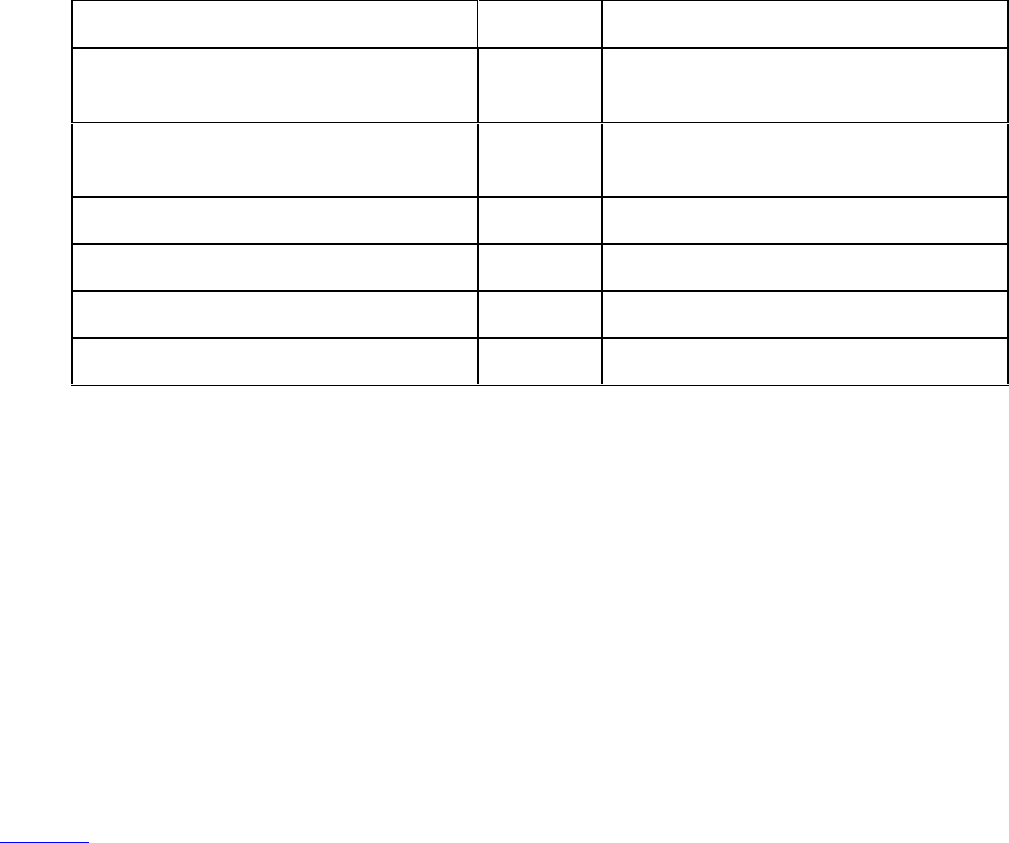
Summary of DO-160C Environmental Testing for Technisonic Model TDFM-600 and 6000 Transceiver.
Conditions
Section
Description of Conducted Tests
Temperature and Altitude
4.0
Equipment tested to categories C4
and D1.
Vibration
8.0
Equipment is tested without shock
mounts to categories B, M and N.
Magnetic Effect
15.0
Equipment is class Z.
Power Input
16.0
Equipment tested to category B.
Voltage Spike
17.0
Equipment tested to category B.
RF Emission
21.0
Equipment tested to category Z.
Installation Approval Note
Presently no TSO standard exists for airborne FM transceivers. To make it easier for installation agencies to provide their
customers with an approved installation supported by an effective Airworthiness Approval, Technisonic has secured
Supplemental Type Certificate (STC) Approvals (both US and Canadian) on its Airborne FM products for many helicopters
currently being delivered in the US and Canada as well as a number of single engine fixed wing aircraft. The above referenced
DO-160C test data is also on file and available from Technisonic to support approval requirements in airframes for which
Technisonic does not possess an STC.
Approved aircraft types are listed in the attachments to the formal STC documents. These STC’s are the exclusive property of
Technisonic and require the written authority of Technisonic for their use. To assist Factory Authorized Technisonic Dealers in
the certification process, we have placed copies of our Canadian and US STC’s on our web site along with a letter of
authorization for their use. These documents may be downloaded and used as support for the technical submission to FAA or
Transport Canada. Only factory authorized dealers/installers are permitted to download and make use of these documents on
behalf of their customers (end users) in support of regulatory agency approval. Please refer to the Technisonic web site
www.til.ca for the latest issue of available STC s and letter of authorization for use.
TABLE OF CONTENTS
Paragraph Title Page
SECTION 1 GENERAL DESCRIPTION
1.1 Introduction.......................................................................................................................1-1
1.2 Description........................................................................................................................1-1
1.3 Technical Summary..........................................................................................................1-1
SECTION 2 OPERATING INSTRUCTIONS
2.1 General.............................................................................................................................2-1
2.14 Radio Service Software ....................................................................................................2-4
SECTION 3 INSTALLATION INSTRUCTIONS
3.1 General.............................................................................................................................3-1
3.2 Equipment Packing Log....................................................................................................3-1
3.3 Transceiver Installation.....................................................................................................3-1
3.4 Installation Kit - Contents..................................................................................................3-1
3.5 Pin Locations and Connections ........................................................................................3-2
3.6 Wiring Instructions............................................................................................................3-3
3.18 Post Installation Tests ......................................................................................................3-7
LIST OF TABLES
Table No. Title Page
3-1 25-pin D Connections.......................................................................................................3-2
LIST OF ILLUSTRATIONS
Figure No. Title Page
3-1 Outline Drawing ................................................................................................................3-1
3-2 Wiring Connections and notes .........................................................................................3-5

1-1
SECTION 1
GENERAL DESCRIPTION
1.1 INTRODUCTION
This publication provides operating and installation information on the TDFM-600/6000 airborne transceiver. (The
exact model number depends on which and how many RF modules are installed.)
1.2 DESCRIPTION
The TDFM-600/6000 series of transceivers are airborne multiband radios capable of conventional FM, P25, SmartNet
and SMART ZONE trunking systems. RF modules are available in VHF, UHFLO, UHFHI and 800 MHz bands. The
bands are numbered 1,4,5 and 8 respectively.
The following are typical model examples:
TDFM-655 - Two UHF high band modules
TDFM-688 - Two 800 MHz modules
TDFM-6148 - One VHF, UHF low and 800 MHz module
TDFM-6158 - One VHF, UHF high and 800 MHz module
1.3 TECHNICAL CHARACTERISTICS
Specification Characteristic
Model Designation: TDFM-600/6000
Physical Dimensions: Approx. 8" X 3" X 5.75"
Weight: 3 Lbs (1.2 kg)
Operating Temperature Range: -30°C to +60°C
Power Requirement:
Voltage: 28.0 Vdc, ± 15%
Current: 165mA minimum
5A maximum
RF Output Power: 1 or 6 Watts (VHF)
1 or 4 Watts (UHF)
1 or 3 Watts (800)
Frequency Range - VHF Module: 136 to 178 MHz
UHF LO Module: 403 to 470 MHz
UHF HI Module: 450 to 512 MHz
800 Module: 764 to 870 MHz
Audio Output Power (including sidetone): 500 mW into 600 ohms
Microphone Inputs: Carbon or Equivalent
Panel Back Lighting: 28 VDC or 5VAC
(specified when ordered)
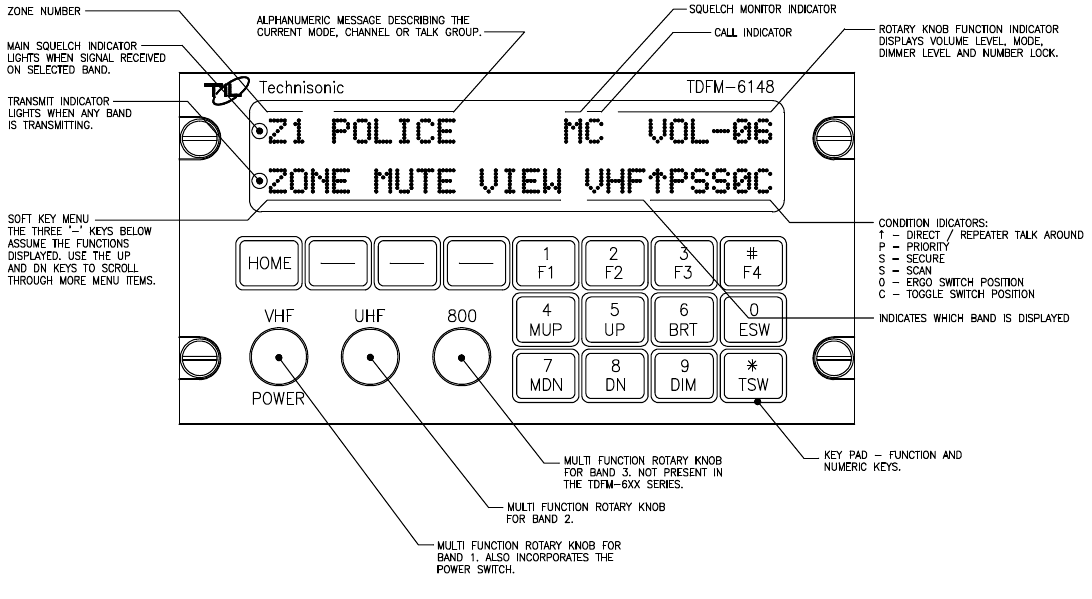
2-1
SECTION 2
OPERATING INSTRUCTIONS
2.1 GENERAL
A 2 line display and a keypad and 2 or 3 rotary knobs provide the operator control of the 2 or 3 RF modules installed in
the unit. The display is showing the activity of one RF module at a time, selected by pressing the desired knob. The
knobs have multiple functions including volume, channel, display dimmer. The microphone, key line and headphone
audio are separate for each of the two or three bands therefore switching from band to band is performed at an audio
panel such as the Technisonic A710 series. This allows for separate and simultaneous operation on each of the bands
just like having 2 or 3 separate radios. If combined operation is desired, a Technisonic AMS-6000 audio mode selector
may be used ahead of the audio controller.
2.2 FRONT PANEL
Refer to the diagram below:
2.3 POWER SWITCH
To switch the transceiver on, press and hold the left most knob until the radio powers up. The display will show
TECHNISONIC and the software version installed followed by the model number as determined by which RF modules
are installed. The display will then show the normal display for band 1. To switch off the transceiver at any time, press
and hold the left most knob for 2 seconds until the display shows OFF then release. If it is desired that the radio comes
on with the radio master in the aircraft, a power jumper may be installed (see installation instructions) such that the
radio is always on.
2-2
2.4 KNOBS
The transceiver will have two or three knobs depending on how many RF modules are installed. The knobs are rotary
encoders which turn endlessly which means their actual position is not important. Each knob also has a push button
incorporated in it so you can press the knob as well as turn it. Pressing a different knob will cause the display and
keyboard to switch to the band associated with that knob. The knob will start out as a volume control. Pressing the
same knob again will change its function to act as the channel/talkgroup selector depending on how that band is
programmed. Pressing the same knob again changes the function of the knob to a display dimmer control. Pressing
the knob again causes the key pad function to change from function keys to number keys. The knob in this mode acts
as a volume control. Another knob press will bring you the recall mode (if this feature is enabled in the configuration
menu). Typing in the channel number will bring you quickly to that channel without scrolling through channels in
between. Pressing the knob again brings it back to the first mode of volume control. The current function of the knob is
shown at the top right of the display. The function of the knobs of the unselected bands are always in volume control
mode. The starting mode (when the band is selected) of the knob can be programmed in the configuration menu to be
VOLUME or CHAN.
2.5 SOFT KEYS AND HOME
The transceiver has three soft keys which assume the function shown above them on the display. The functions
displayed depend on how the module was programmed with the radio service software (CPS)™. Functions can be
different on a channel by channel basis as well. These may include:
ZONE - Pressing this function will prompt you for a new zone number which can be entered directly or scrolled
using the UP and DN keys.
MUTE - Selecting this function will prompt you for an on or off entry using the soft keys to mute the tones.
Tones refer to the beeps heard when pressing buttons.
VIEW - The view function is used to view lists. Lists can include phone numbers, call lists and or page.
PWR - Selecting PWR will allow the power output of the radio to be set to high or low.
PROG - Selecting PROG allows brings you to user programmable features of the radio such as telephone
numbers. The ability for the user to program phone numbers, etc can be enabled or disabled by the
CPS™.
At any time while in one of these functions, you can escape back to the normal mode by pressing the HOME key.
When programming the modules with the CPS™, it is suggested not to double up functions. For example,
programming a soft key to CHAN would be redundant since there is already a channel function using the knobs. Using
the CHAN soft key would also not update the channel number on the display, causing some confusion.
2.6 FUNCTION KEYS
Four function keys at the top of the keypad provide the same actions as the three side buttons and the top button found
on the XTS-3000 portable. They are as follows:
F1 - Top side button (purple button) on the portable.
F2 - Center side button (with one dot) on the portable.
F3 - Bottom side button (with two dots) on the portable.
F4 - Top button (orange button) on the portable.

2-3
TDFM-600/6000 Transceiver Recommended Keypad Menu Defaults:
TDFM-600/6000
ITEM
Portable
ITEM
Conventional
Operation (H35)
SmartNet
Operation (H37)
SMARTZONE
Operation (H38)
F1 Key
Top Side
Button 1
Monitor
Phone
Phone
F2 Key
Center Side
Button 2
Scan
Scan
Scan
F3 Key
Bottom Side
Button 3
Talkaround/
Direct
Private Call
Site
Display/Search
F4 Key
Orange (Top)
Button
Emergency
Emergency
Emergency
MUP and
MDN keys
16-Position
Rotary Knob
Channel Select
Channel Select
Channel Select
ESW Key
Two-Position
Concentric or
Ergo Switch
Blank (O)
Low Power (∅)
Blank (O)
Low Power (∅)
Blank (O)
Low Power (∅)
TSW Key
Three-Position
Toggle Switch
Blank (A)
Scan (B)
Blank (C)
Blank (A)
Scan (B)
Blank (C)
Blank (A)
Scan (B)
Blank (C)
Note: It is possible to use Motorola’s Radio Service Software (RSS™ or CPS™) to alter the default keypad settings
of the TDFM-600/6000 series radios. However if custom key settings are chosen it will not be possible for
Technisonic to help the Pilot or other Radio User through operational difficulties. These questions will have to
be referred to the Radio System Administrator responsible for customising the settings. Technisonic
recommends that the default key settings stay in place until all airframe installation and operational issues
have been overcome.
The TDFM-600/6000 series Transceivers are programmable by Motorola Radio Service Software. The following
settings may be programmed for each Channel in a Conventional Radio:
Tx Frequency Zone
Tx PL/DPL Code Channel
Rx Frequency Name
Rx PL/DPL Code RX Signal Voice Type
Time-Out Timer TX Signal Voice Type
Scan List Network Access Code
Phone Tx Power
Smart PTT
2-4
The following settings must be programmed for each mode in a Trunked (SmartNet or SMARTZONE) Radio:
System Type TG Strapping
System ID Zone
Individual ID Scan List
Coverage Type Scan Type
Affiliation Type Interconnect
Control Channel 1 Phone Display Format
Control Channel 2 Private Call
Talkgroup 1 Private Call Type
Talkgroup 2 Private Call Operation
The function keys along with the rest of the key pad, revert to normal number keys during transmit and when NUM
LOCK is selected by pressing the rotary knob.
2.7 MUP AND MDN KEYS
These keys provide the same function as the rotary knob does when it is set to CHAN. This equates to the 16 position
rotary knob on the portable. When one of these keys is pressed, the function of the rotary knob is automatically set to
CHAN.
2.8 UP AND DN KEYS
The keys provide the same function as the left and right arrow keys on the portable. The UP key equates to the right
arrow key. These keys are used for a variety of functions but in the normal mode they are used to scroll through the
soft key menus.
2.9 BRT AND DIM KEYS
Use these keys to dim or brighten the display. The radio powers up at full brightness for normal use but can be
dimmed for night operations.
2.10 ESW KEY
The ESW key provides the function of the concentric or ‘ergo’ switch on the portable. The switch has two conditions
which are represented by ‘O’ and ‘∅’. Pressing the ESW key toggles the condition back and forth. The condition is
displayed at the bottom of the display, second character from the right. The ergo switch condition is saved when the
unit is turned off. There are separate conditions for each band installed. The ESW key can be programmed with the
CPS™ to a variety of functions such as low power, scan, channel, and secure mode.
2.11 TSW KEY
The TSW key provides the function of the toggle switch on the portable. The switch has three conditions which are
represented by ‘A’, ‘B’ and ‘C’. Pressing the TSW key toggles the condition A,B,C,A,B, etc. The condition is displayed
at the bottom of the display, last character on the right. The toggle switch condition is saved when the unit is turned off.
There are separate conditions for each band installed. The TSW key can be programmed with the CPS™ to a variety
of functions such as low power, scan, channel, and secure mode.
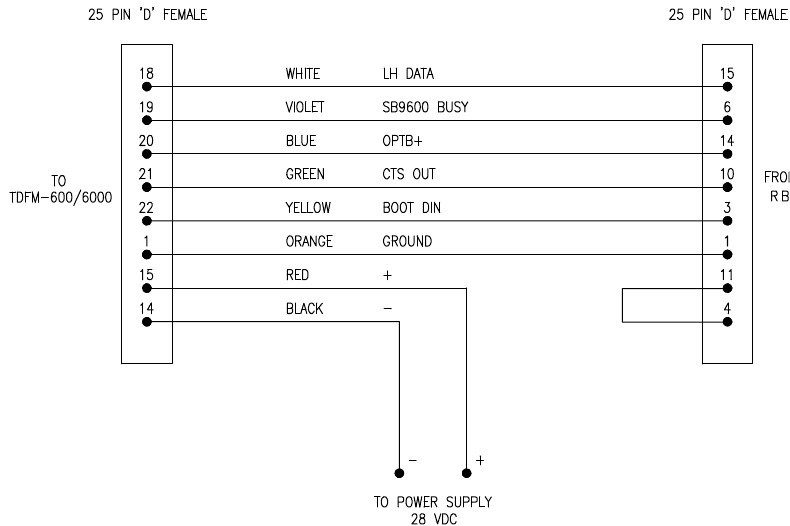
2-5
2.12 DISPLAY
The transceiver has a two line, 48 character LED display which gives information about the selected band. On the top
line is shown the zone number, channel name and rotary knob function. The bottom line displays the soft key menu,
the band selected, and the ESW/TSW condition. Also displayed are letters and symbols indicating scan,
direct/repeater talk around, monitor, secure, priority and call. In addition to the character display, there are two LED
indicators on the left. The top LED indicates a signal is being received on the selected band while the bottom LED
indicates that any one or more of the installed bands are transmitting.
2.13 GENERAL OPERATION
Switch on the transceiver as described in 2.3. Select the desired band by pressing the appropriate knob. Select the
same band on the audio panel. Press the knob again so that CHAN shows up on the top right of the display. Rotate the
knob until the desired channel or talk group is selected. Press the knob until VOL is again shown on the display. You
can adjust the volume by waiting until a signal is received or by pressing F1 (factory programmed for monitor function)
and adjusting the rotary knob. The radio is ready to use. Remember that the band selected by pressing the rotary
knobs is what is displayed on the screen but the band selected by the audio panel is band that you are actually
transmitting and receiving on. If another band is displayed, the rotary knob for the band you are using is still operating
the volume level. To use the DTMF key pad while transmitting, the band you are using must be displayed on the
screen.
2.14 RADIO SERVICE SOFTWARE (RSS™ for DOS or CPS™ or Windows)
To make any changes to the programming in the radio, RSS™ or CPS™ software must be used. There is no provision
in the radio to allow the user to change frequencies, zones, talk groups, etc. CPS™ software can be purchased from
your local Motorola dealer. A Motorola Radio Interface Box (RIB) is required to connect the computer to the TDFM-
600/6000. Each band in the TDFM-600/6000 is considered an XTS-3000 (normally) or an XTS-5000 (upgrade)
portable by the CPS™ software. To program a band in the transceiver, it must be selected by pressing the appropriate
knob before running the CPS™. Follow the instructions supplied with the CPS™ and RIB. The radio cable supplied
with the RIB will not connect to the TDFM-600/6000, therefore you will need to fabricate or purchase the XTS-3000 or
XTS-5000 type programming cable.
FIGURE 2-2
XTS-3000
Programming
Cable
(Requires RIB)
2-6
2.15 CONFIGURATION MENU
Some features of the TDFM-600/6000 transceiver can be configured to the user’s preference. To enter the
configuration menu, turn the unit on while simultaneously pressing the F4, ESW and TSW keys. Hold the keys
until the display reads ‘Configuration Menu’. The first menu item to show will be ‘Knob Default’. Rotating the left
knob will toggle back and forth between ‘volume’ and ‘channel’. This will select which mode the knobs will be in
when you select a band or when the radio is first turned on. Press the left knob to accept the desired setting. The
next menu item is ‘Recall Mode’. Rotating the left knob will enable and disable this feature. When enabled, a
recall mode is added to the available knob functions. Press the left knob to accept the desired setting. The last
menu item is the ‘Auto reset’ function. Rotating the left knob will toggle the function ‘enabled’ or ‘disabled’. This
function should be left enabled. However, if a module has failed or has been removed from the radio, this feature
should be disabled to prevent the radio from continuously trying to establish communication with the missing or
failed module. Press the left knob to accept the setting. The radio will then power up normally. The radio will keep
these settings until they are changed again by the configuration menu.
2.16 FLASH UPGRADE MODE
On occasion it may be required to flash upgrade one or more of the modules in the radio to change or add new
features. This can be done using the Motorola RIB box and software supplied in a Motorola flash upgrade kit. The
transceiver must be put into flash upgrade mode by turning on the radio while holding the HOME key. Select the
band to be upgraded by pressing the desired band knob. Follow the software instructions. During the flash
procedure, the software will ask you to turn off and on the radio, use the RESET soft key, do not turn off the
transceiver.
3-1
SECTION 3
INSTALLATION INSTRUCTIONS
3.1 GENERAL
This section contains information and instructions for the correct installation of the TDFM-600/6000 Transceiver.
3.2 EQUIPMENT PACKING LOG
Unpack the equipment and check for any damage that may have occurred during transit. Save the original shipping
container for returns due to damage or warranty claims. Check that each item on the packing slip has been shipped in
the container.
3.3 INSTALLATION
The TDFM-600/6000 Transceiver is designed to be dzus mounted and should be installed in conjunction with an IN-
600 installation kit. See figure 3-1 for an outline drawing of the unit with dimensions to facilitate the installation.
3.4 INSTALLATION KIT - CONTENTS
The IN-600 installation kit (P/N 019301-1) consists of:
1. One 25 pin Cannon D mating connector (female) complete with crimp pins and hood.
2. 3 BNC connectors.
3.5 ANTENNA INSTALLATION
The type and number of antennas depends on the model of transceiver being installed. The following is a list of
recommended antennas for the various RF modules:
VHF 136 to 176 MHz Comant part # CI-292
UHFLO 403 to 470 MHz Comant part # CI-275
UHFHI 450 to 512 MHz Comant part # CI-275
800 764 to 870 MHz Comant part # CI-306
The antenna should be mounted on the bottom of the aircraft whenever possible. Consult with instructions provided
with the antenna. Connect the RF cables to the back of the transceiver using the BNC connectors provided in the
installation kit.
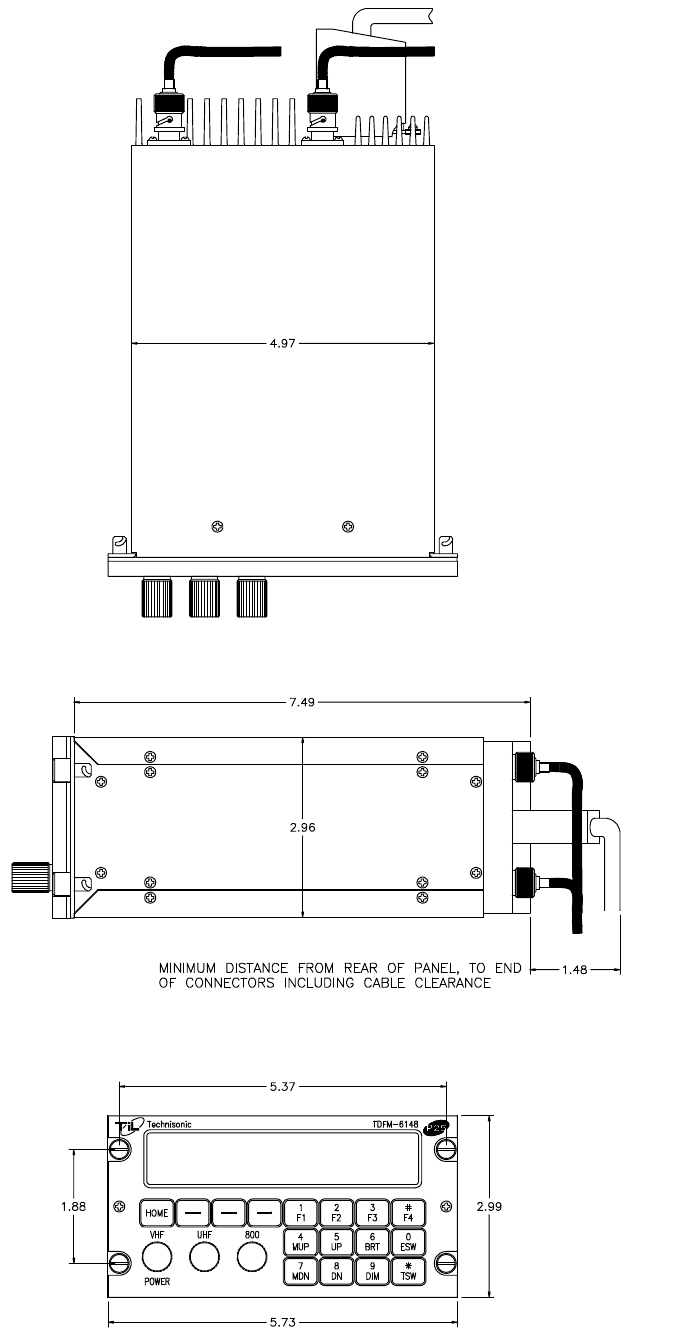
3-2
FIGURE 3-1 Outline Drawing for Model TDFM-600/6000
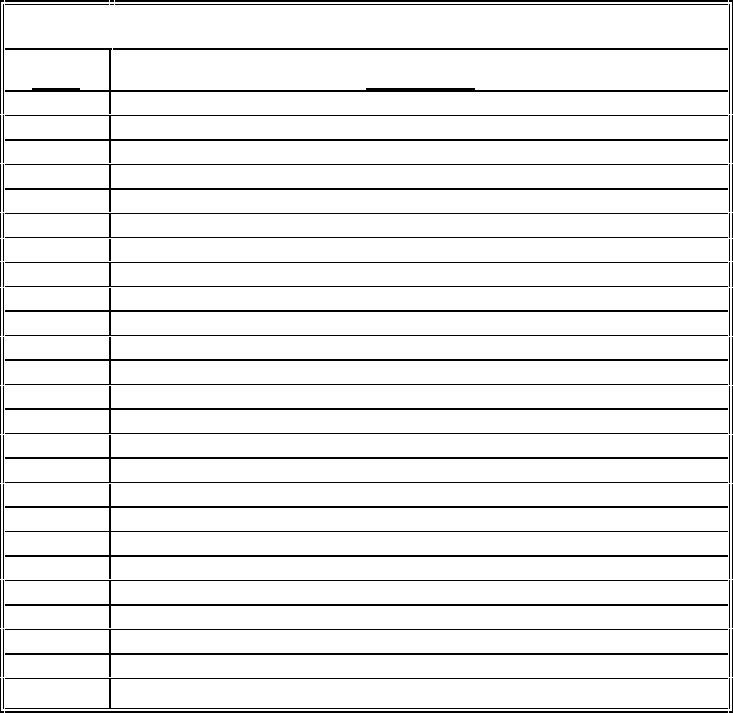
3-3
3.6 INSTALLATION - PIN LOCATIONS AND CONNECTIONS
J1 - 25 Pin D Connections - Use FEMALE Connector
Pin #
Description
1 Ground
2 Main Power +28 VDC
3 Mic 1
4 Audio 1
5 PTT 1
6 Mic 2
7 Audio 2
8 PTT 2
9 Mic 3
10 Audio 3
11 PTT 3
12 TX Data
13 RX Data
14 Ground
15 Main Power +28 VDC
16 Channel Up
17 Channel Down
18 LH Data
19 SB9600 Busy
20 OPTB+
21 CTS Out
22 Boot DIN
23 RTSBIN
24 RS232DIN
25 Panel Backlighting
TABLE 3-1
3.7 INSTALLATION - WIRING INSTRUCTIONS
Figure 3-2 shows all required connections and recommended wire sizes for the TDFM-600/6000 transceiver.
3.8 MAIN GROUND - PINS 1 AND 14
Both pins should be connected to ground. The main ground is internally connected to the chassis.
3.9 MAIN POWER +28 VDC - PINS 2 AND 15
Both pins should be connected to +28 volts DC +/- 15%.
3-4
3.10 MIC 1, 2 AND 3 - PINS 3, 6 AND 9
The microphone input signals shall be connected using shielded wire with the shield connected to ground (pin 1 or
14). It is recommended for best results to leave the other end of the shield floating to prevent ground currents
unless you are connecting to an audio panel with floating hi and lo inputs (like the Technisonic A710 or A711
series) in which case the shield must be connected to the lo input.
3.11 AUDIO 1, 2 AND 3 - PINS 4, 7 AND 10
Audio outputs 1, 2 and 3 are 600 ohms impedance against ground. The output power is 500 mW maximum.
3.12 PTT 1, 2 AND 3 - PINS 5, 8 AND 11
The PTT lines should be floating when in receive and grounded for transmit. The input has a pull up resistor to 5
volts. Connecting an audio panel which wishes to see more, may result in no receive audio. Connect a 1N4006
diode in series with the cathode towards the audio panel in this case.
3.13 TX DATA AND RX DATA - PINS 12 AND 13
These are an RS-232 serial port for the RC-6000 remote control head if installed. Consult the RC-6000 installation
manual for details.
3.14 CHANNEL UP AND CHANNEL DOWN - PINS 16 AND 17
These pins can be used to scroll up and down through the zone/channel/mode/talk group selections for the band
currently displayed on the screen. The inputs normally floating are grounded to activate. Two push buttons or a
center off, SPDT, spring loaded toggle switch are typically used on these inputs.
3.15 LH DATA, SB9600 BUSY, OPTB+, CTS OUT, BOOT DIN, RTSBIN AND RS232DIN - PINS 18 THROUGH 24
These pins are used for programming or updating the transceiver using Motorola Radio Service Software (RSS™)
or encryption key loading and are generally left unconnected. However, if it is desirable to update the radio without
removing it from the aircraft, these lines can be run to a 25 pin D male connector located on the panel where a
laptop computer can plug in. Use the same pin numbers so the programming cable described in section 2 can be
used (minus the power pins).
3.16 PANEL BACKLIGHTING - PINS 25
Connect to aircraft panel dimming bus. The transceiver comes with either 28 VDC or 5 VAC backlighting circuits.
Check the label on the side of the transceiver before applying power.
3.17 POWER JUMPER
The radio must be turned on manually each time the avionics bus is switched on. If it is desired that the radio
comes on with the radio master in the aircraft, remove the right side panel from the radio and install a 0.1” jumper
across JP1 (two pins) near the rear of the radio on the right side of the MCU board. If you attempt to turn off the
radio with the jumper installed, it will just come back on again in 5 seconds.
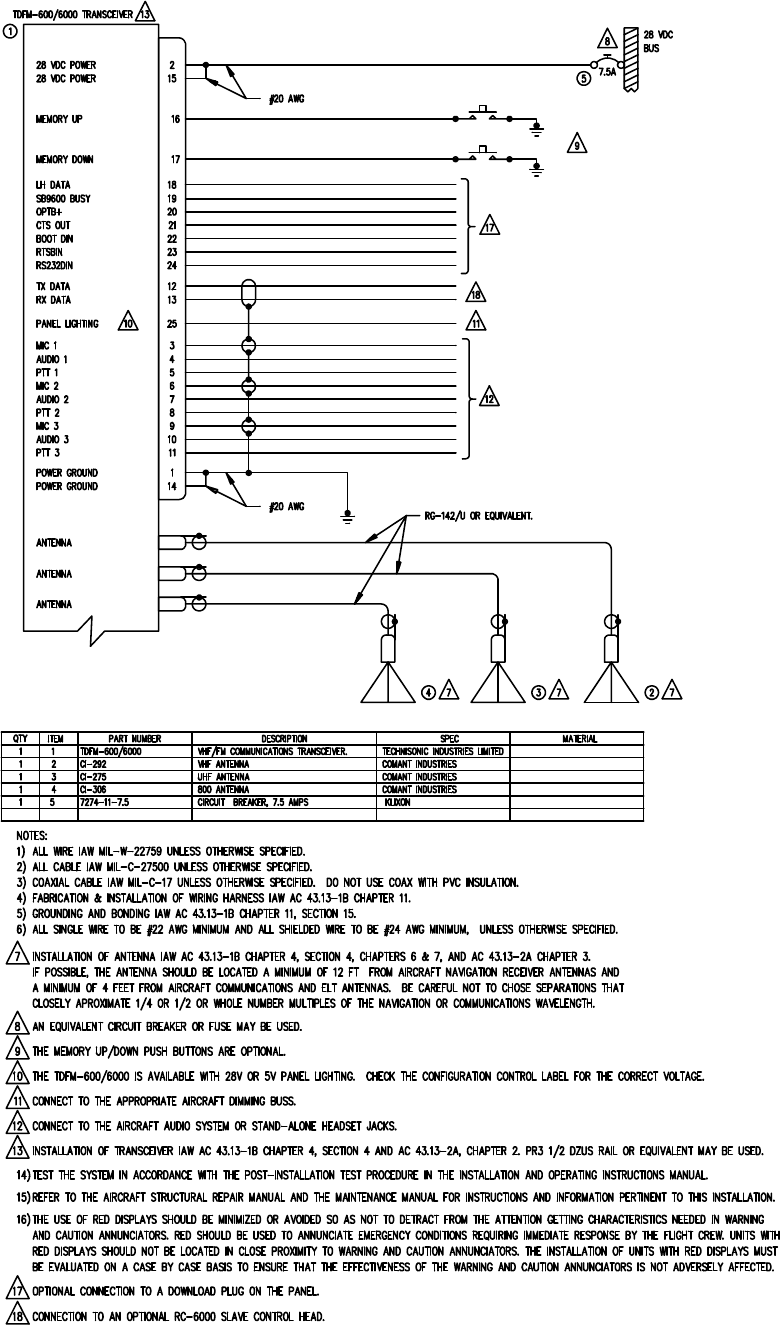
3-5
FIGURE 3-2 Wiring connections and notes for the TDFM-600/6000 Transceiver
3-6
3.18 POST INSTALLATION EMI TEST
PURPOSE
The purpose of this test is to identify any interference that the TDFM-600/6000 transceiver
may cause with existing aircraft systems.
TEST CONDITIONS
The TDFM-600/6000 transceiver should be installed and function tested. The antenna VSWR
should be checked. A forward/reverse power check with a in-line wattmeter should show no
more than 10% reflected power. For the following tests, insure that the output power is set to
high.
METHODOLOGY
Most of the EMI tests can be accomplished on the ground. In some cases flight testing is
required or is easier. If the aircraft is approved for IFR operations, then it is mandatory that
interference between the TDFM-600/6000 transceiver and the approach aids be checked in
flight.
The GPS should be operational and navigating with at least the minimum compliment of
satellites. The VHF comm should be set to the frequencies indicated with the squelch open.
VOR/DME receivers should be set to the frequencies indicated and selected for display. If
possible, set up a DME ramp test set on the frequencies indicated and adjust the output until
the flags are out of view. The transponder and encoder should be monitored with ramp test
equipment. Set the output of the transponder test set to 3db above the output necessary to
achieve 90% reply. If possible set the ADF to a nearby navigation station.
Modulate the TDFM-600/6000 transmitter on the indicated frequencies for at least 20 seconds.
Observe the GPS for any degradation in satellite status or availability or flags. Listen for any
noise or detected audio signals on the VHF comm(s). Listen for any noise or detected audio
signals on the VOR/LOC receiver audio; look for any moment of flags or needles on the
VOR/LOC/GS navigation display(s). Observe the transponder for any loss of reply or spurious
reply.
List the power plant, fuel and other electric instruments in the chart provided and note any
anomalies that occur while transmitting. Assess the results.
If the aircraft is equipped with an autopilot or a stability augmentation system, then test fly the
aircraft and verify that operation of the TDFM-600/6000 transceiver does not have adverse
effects on these systems. After checking for gross effects at a safe altitude, fly an approach
with each of the different navigation systems coupled to the autopilot (ILS, GPS ETC.) and
look for any anomalies.
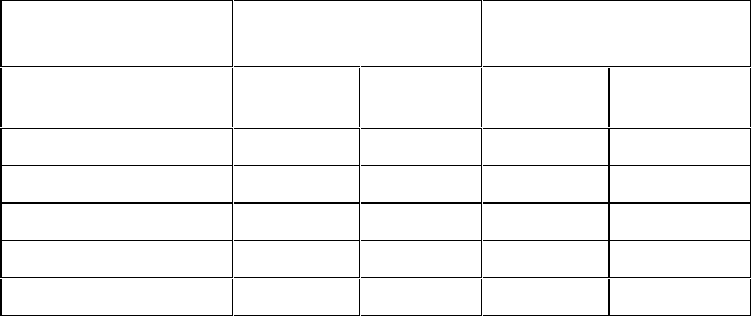
3-7
RESULTS
If the installed system passes all of the applicable EMI tests, then no further action is required.
If interference is observed then the interference must be assessed against the appropriate
standards of airworthiness for the system in question. For example it is permissible for a VFR
certified GPS to lose navigation capability while the TDFM-600/6000 unit is transmitting,
providing that it recovers properly and promptly, but it is not permissible for an IFR Approach
certified GPS to be affected in the same way. A complete discussion of all the standards of
airworthiness to be applied in assessing EMI effects is beyond the scope of this document.
PROCEDURE
A. Operate the TDFM-600/6000 transmitter on the following frequency for at least 20 seconds.
Observe the GPS for any degradation in satellite status or availability or flags.
FREQUENCIES
GPS #1
GPS #2
TDFM-600/6000
PASS
FAIL
PASS
FAIL
143.2125 MHz
143.2250 MHz
157.5375 MHz
157.5500 MHz
512 MHz
NOTES:
B. Determine if the image frequency for the VHF Comm falls within the range of the TDFM-
600/6000. If so, select a set of frequencies that will cause the TDFM-600/6000 to be set as
close as possible to the image frequency. Any one of the many possible sets will suffice.
Record those values in the spaces provided in the following chart. Modulate the TDFM-
600/6000 transmitter on the following frequencies for at least 20 seconds. Listen for any noise
or detected audio signals on the VHF comm.
Example - Bendix/King KY 196A:
The first IF frequency is 11.4 MHz. The L.O. is above the received frequency (high side
injection), therefore the image frequency is 22.8 MHz above the selected frequency. Set the
KY 196A to 120.000 MHz and the TDFM-600/6000 to 142.8000 MHz.
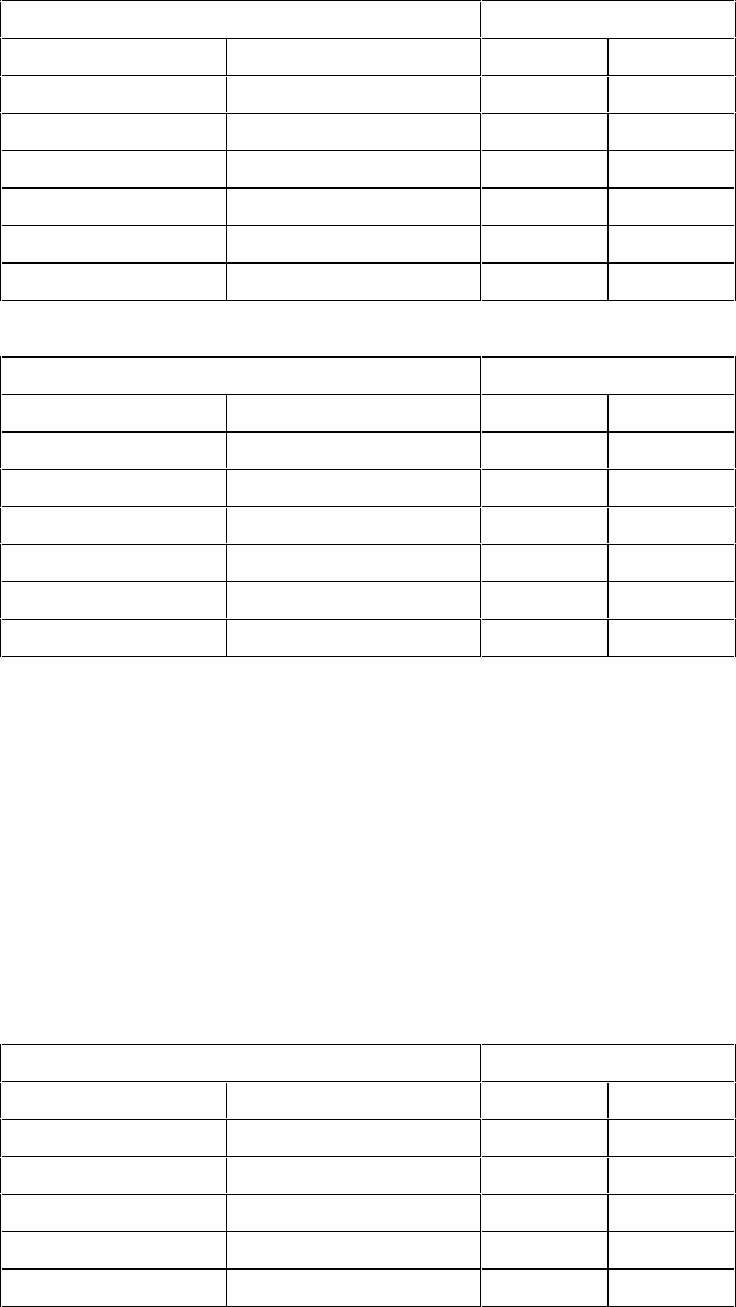
3-8
FREQUENCIES RESULTS
VHF #1 TDFM-600/6000 PASS FAIL
135.975
136.0000
121.150
157.5000
131.250
157.5000
Image:
FREQUENCIES RESULTS
VHF #2 TDFM-600/6000 PASS FAIL
135.975
136.0000
121.150
157.5000
131.250
157.5000
Image:
NOTES:
C. Determine if the image frequency for the VOR/ILS Nav falls within the range of the TDFM-
600/6000. If so, select two sets of frequencies that will cause the TDFM-600/6000 to be set as
close as possible to the image frequency. Choose one set in the localizer frequency range
and one in the VOR frequency range. Record those values in the spaces provided in the
following chart. Modulate the TDFM-600/6000 transmitter on the following frequencies for at
least 20 seconds. Listen for any noise or detected audio signals on the receiver audio; look
for any moment of flags or needles on the navigation display.
FREQUENCIES RESULTS
VOR/ILS #1 TDFM-600/6000 PASS FAIL
108.000
162.0000
108.100
162.1500
Image:

3-9
FREQUENCIES RESULTS
VOR/ILS #2 TDFM-600/6000 PASS FAIL
108.000
162.0000
108.100
162.1500
Image:
NOTES:
D. Modulate the TDFM-600/6000 transmitter on the following frequencies for at least 20 seconds.
Observe the Glideslope displays. Look for any movement of flags or needles on the
navigation display.
FREQUENCIES
RESULTS
G/S #1
TDFM-600/6000
PASS
FAIL
334.7 (108.1)
167.35
FREQUENCIES
RESULTS
G/S #2
TDFM-600/6000
PASS
FAIL
334.7 (108.1)
167.35
NOTES:

3-10
E. Operate the TDFM-600/6000 transmitter on the following frequency for at least 20 seconds.
Observe the Transponder for any spurious replies or loss of reply to test set.
FREQUENCIES
TRANSPONDER #1
TRANSPONDER #2
TDFM-600/6000
PASS
FAIL
PASS
FAIL
512 MHz
NOTES:
F. Modulate the TDFM-600/6000 transmitter on the following frequencies for at least 20 seconds.
Observe the DME displays. Look for loss of distance information on the display.
FREQUENCIES
RESULTS
DME 1
TDFM-600/6000
PASS
FAIL
978 (108.0)
489
1020 (112.1)
510
FREQUENCIES
RESULTS
DME 2
TDFM-600/6000
PASS
FAIL
978 (108.0)
489
1020 (112.1)
510
NOTES:

3-11
NOTE:
For the following tests, select a frequency at the top, middle and bottom of each band of the TDFM-
600/6000 transceiver.
136 to 178
MHz Band
403 to 470
MHz Band
450 to 512
MHz Band
806 to 870
MHz Band
Frequency
#1
Frequency
#2
Frequency
#3
H. At a safe altitude engage the autopilot or stability augmentation system. Modulate the TDFM-
600/6000 transmitter on the above frequencies for at least 20 seconds. Observe any effect on
the autopilot or stability augmentation system.
Observations:
I. Perform a coupled ILS approach to the aircraft’s certified limits. Modulate the TDFM-600/6000
transmitter on the above frequencies for at least 20 seconds. Observe any effect on the
autopilot. Repeat for second flight director/autopilot if equipped.
Observations:

3-12
J. List the power plant, fuel and other electric instruments in the chart provided and note any
anomalies that occur while transmitting. Assess the results.
STEP
SYSTEM
PASS
FAIL
NOTES
1
Com 1&2
(UHF Lo, UHF Hi, and 800
MHz)
2
Transponder & Encoder
(VHF, UHF Lo, and 800
MHz)
3
ADF 1 & 2
4
VG
5
Glideslope 1&2
(UHF Lo, UHF Hi, and 800
MHz)
6
VOR/LOC 1&2
(UHF Lo, UHF Hi, and 800
MHz)
7
Compass
8
Directional Gyro
9
Fuel Pressure
10
Oil Temp
11
Amps

3-13
STEP
SYSTEM
PASS
FAIL
NOTES
12 Bus Voltage
13
Fuel %
14
Ng
15
TOT
16
Torque %
17
Annunciators
18
Digital Clock
19
Oil Pressure
20
DME 1&2
(VHF, UHF Lo, and 800
MHz)
21
GPS 1&2
(UHF Lo and 800 MHz)

3-14
STEP
SYSTEM
PASS
FAIL
NOTES
NOTES: